Friedrich Wolf-Monheim
Spectral and Rhythm Feature Performance Evaluation for Category and Class Level Audio Classification with Deep Convolutional Neural Networks
Sep 09, 2025Abstract:Next to decision tree and k-nearest neighbours algorithms deep convolutional neural networks (CNNs) are widely used to classify audio data in many domains like music, speech or environmental sounds. To train a specific CNN various spectral and rhythm features like mel-scaled spectrograms, mel-frequency cepstral coefficients (MFCC), cyclic tempograms, short-time Fourier transform (STFT) chromagrams, constant-Q transform (CQT) chromagrams and chroma energy normalized statistics (CENS) chromagrams can be used as digital image input data for the neural network. The performance of these spectral and rhythm features for audio category level as well as audio class level classification is investigated in detail with a deep CNN and the ESC-50 dataset with 2,000 labeled environmental audio recordings using an end-to-end deep learning pipeline. The evaluated metrics accuracy, precision, recall and F1 score for multiclass classification clearly show that the mel-scaled spectrograms and the mel-frequency cepstral coefficients (MFCC) perform significantly better then the other spectral and rhythm features investigated in this research for audio classification tasks using deep CNNs.
Spectral and Rhythm Features for Audio Classification with Deep Convolutional Neural Networks
Oct 09, 2024Abstract:Convolutional neural networks (CNNs) are widely used in computer vision. They can be used not only for conventional digital image material to recognize patterns, but also for feature extraction from digital imagery representing spectral and rhythm features extracted from time-domain digital audio signals for the acoustic classification of sounds. Different spectral and rhythm feature representations like mel-scaled spectrograms, mel-frequency cepstral coefficients (MFCCs), cyclic tempograms, short-time Fourier transform (STFT) chromagrams, constant-Q transform (CQT) chromagrams and chroma energy normalized statistics (CENS) chromagrams are investigated in terms of the audio classification performance using a deep convolutional neural network. It can be clearly shown that the mel-scaled spectrograms and the mel-frequency cepstral coefficients (MFCCs) perform significantly better then the other spectral and rhythm features investigated in this research for audio classification tasks using deep CNNs. The experiments were carried out with the aid of the ESC-50 dataset with 2,000 labeled environmental audio recordings.
ConvDTW-ACS: Audio Segmentation for Track Type Detection During Car Manufacturing
Feb 28, 2024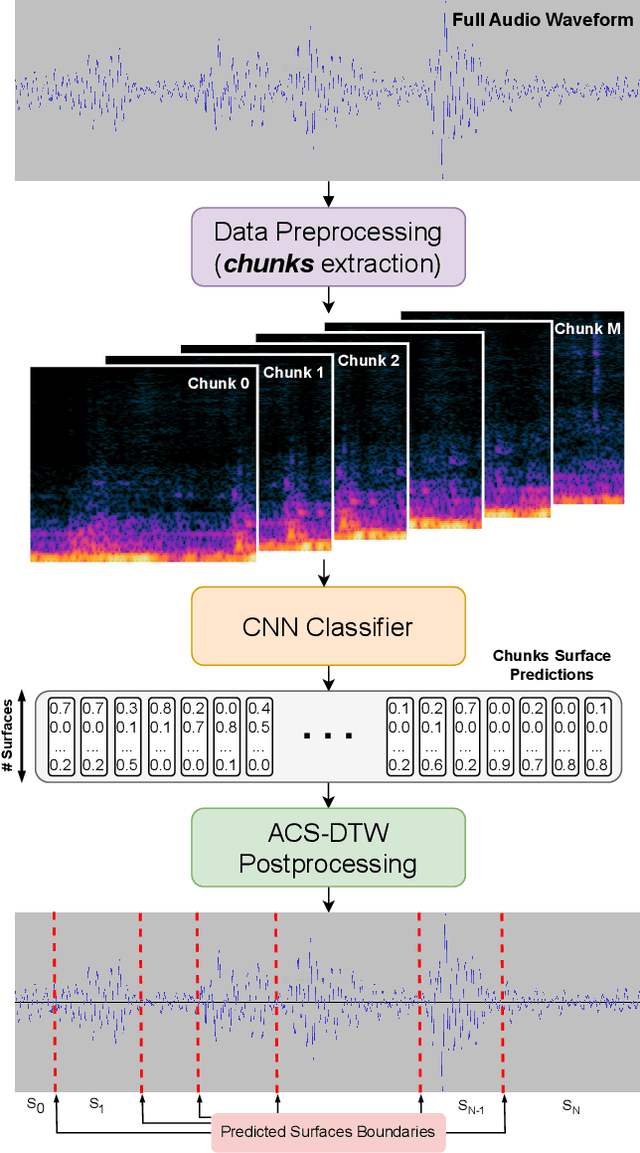
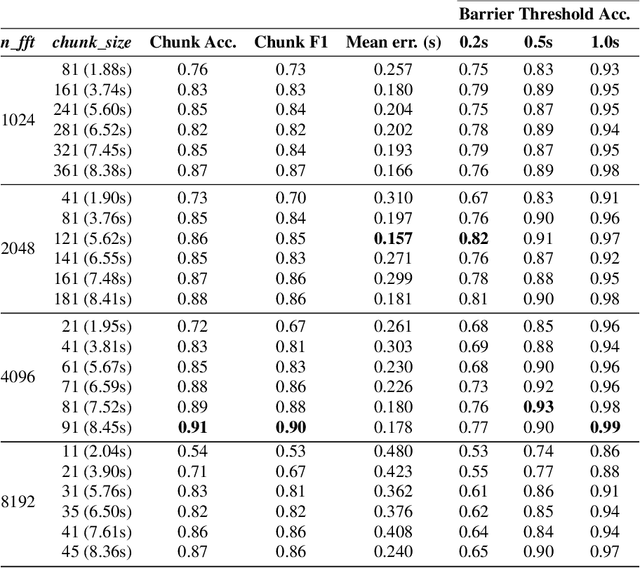
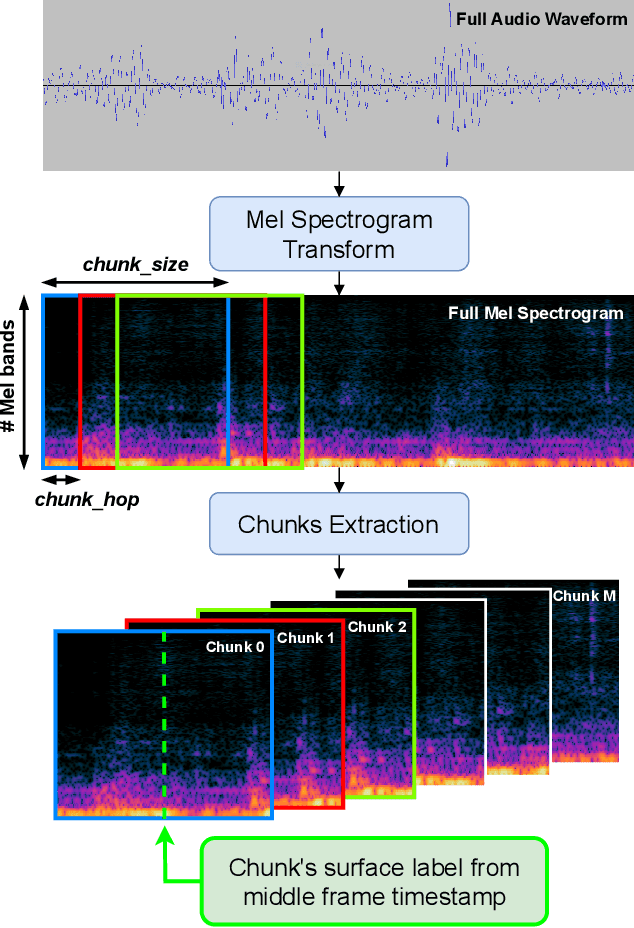

Abstract:This paper proposes a method for Acoustic Constrained Segmentation (ACS) in audio recordings of vehicles driven through a production test track, delimiting the boundaries of surface types in the track. ACS is a variant of classical acoustic segmentation where the sequence of labels is known, contiguous and invariable, which is especially useful in this work as the test track has a standard configuration of surface types. The proposed ConvDTW-ACS method utilizes a Convolutional Neural Network for classifying overlapping image chunks extracted from the full audio spectrogram. Then, our custom Dynamic Time Warping algorithm aligns the sequence of predicted probabilities to the sequence of surface types in the track, from which timestamps of the surface type boundaries can be extracted. The method was evaluated on a real-world dataset collected from the Ford Manufacturing Plant in Valencia (Spain), achieving a mean error of 166 milliseconds when delimiting, within the audio, the boundaries of the surfaces in the track. The results demonstrate the effectiveness of the proposed method in accurately segmenting different surface types, which could enable the development of more specialized AI systems to improve the quality inspection process.
Designing MacPherson Suspension Architectures using Bayesian Optimization
Jun 17, 2022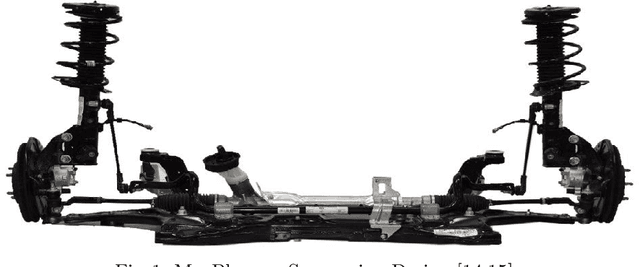
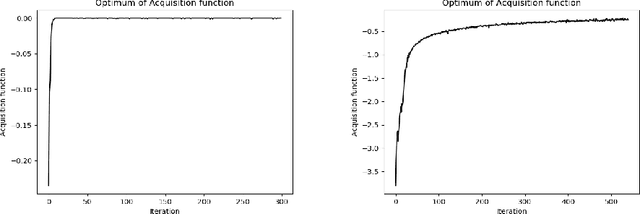
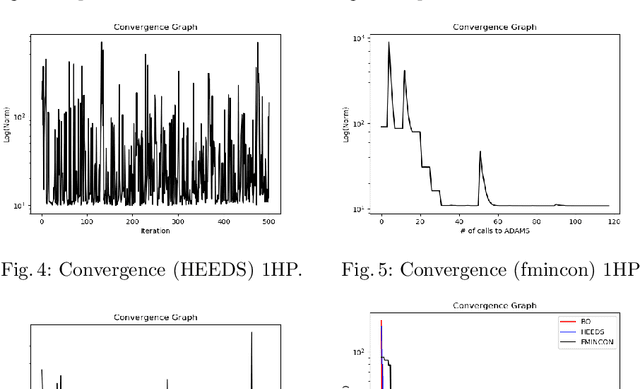

Abstract:Engineering design is traditionally performed by hand: an expert makes design proposals based on past experience, and these proposals are then tested for compliance with certain target specifications. Testing for compliance is performed first by computer simulation using what is called a discipline model. Such a model can be implemented by a finite element analysis, multibody systems approach, etc. Designs passing this simulation are then considered for physical prototyping. The overall process may take months, and is a significant cost in practice. We have developed a Bayesian optimization system for partially automating this process by directly optimizing compliance with the target specification with respect to the design parameters. The proposed method is a general framework for computing a generalized inverse of a high-dimensional non-linear function that does not require e.g. gradient information, which is often unavailable from discipline models. We furthermore develop a two-tier convergence criterion based on (i) convergence to a solution optimally satisfying all specified design criteria, or (ii) convergence to a minimum-norm solution. We demonstrate the proposed approach on a vehicle chassis design problem motivated by an industry setting using a state-of-the-art commercial discipline model. We show that the proposed approach is general, scalable, and efficient, and that the novel convergence criteria can be implemented straightforwardly based on existing concepts and subroutines in popular Bayesian optimization software packages.
 Add to Chrome
Add to Chrome Add to Firefox
Add to Firefox Add to Edge
Add to Edge